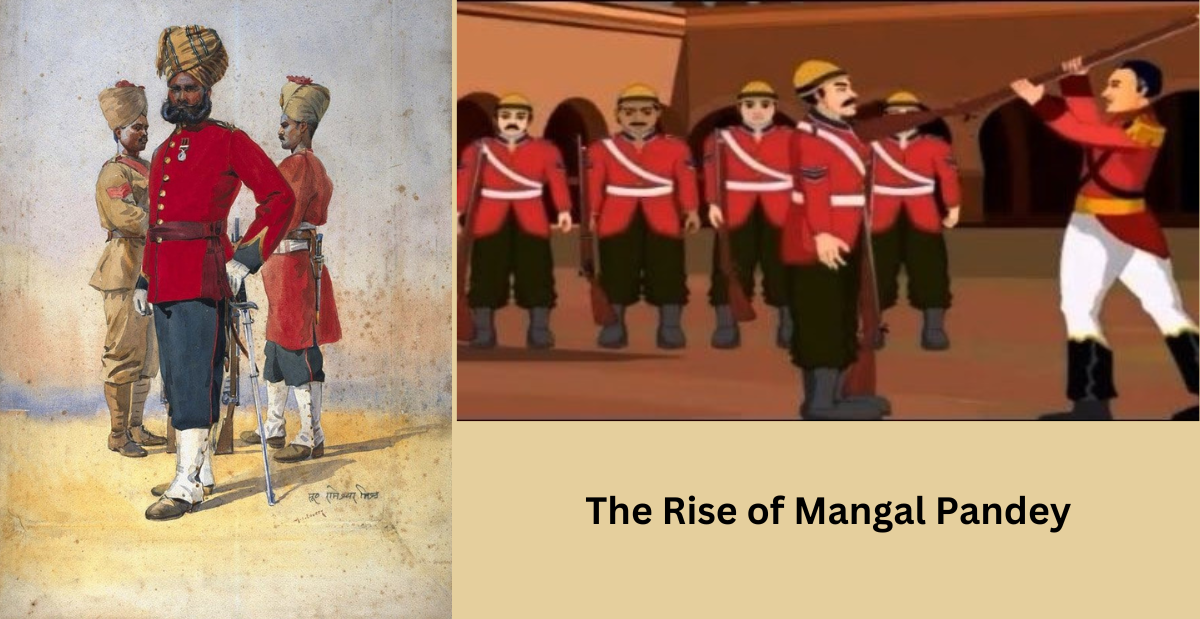In the legend story of the Rise of Mangal Pandey. Mangal Pandey was such a brave warrior who had sounded the trumpet of the first war of independence. And had made the British government realize the strength of Indians with his fearless personality. Due to the rebellion started by him, the fire of getting freedom flared up in the minds of all the Indians and then after many years of struggle and battles, our country could get freedom from the clutches of the British.
Mangal Pandey was a great freedom fighter, who even sacrificed his life to protect the country. Let us know about some important and interesting events related to the life of Mangal Pande, the first revolutionary of the freedom struggle. Now, studied about “The Rise of Mangal Pandey”.

Read About: Jhansi Ki Rani Lakshmi Bai
Introduction of “The Rise of Mangal Pandey”
In the middle of the nineteenth century. Barrackpore, 16 miles away from Calcutta, was a quiet military cantonment. The largest number of Indian soldiers in eastern India were stationed here and it was also the residence of the British Governor General. As early as 1857, no one could have imagined that it could not have been predicted that the first bugle of rebellion against the British would be sounded from this cantonment itself and became the legend story of “The Rise of Mangal Pandey. 29 March 1857 was Sunday, but the peace of Sunday afternoon was disturbed by a soldier Mangal Pandey. Famous historian Rudranshu Mukherjee in his book Dateline 1857 Revolt against the Raj.
Read About: Cause of Revolt 1857
Famous historian Rudrankshu Mukherjee writes in his book The Date Line 1857 Revolt Against the Raj that at that time Mangal Pandey was wearing the coat of his regiment, but instead of trousers he was wearing dhoti. He carried a loaded rifle and was barefoot. He shouted and addressed the soldiers who had reached there, saying, “Firangi is here, why are you not getting ready? By just biting these bullets, we will become corrupt. Stand up for the sake of religion. You have told me all this. You have provoked me to do this but now you are not supporting me.”
Biography of “The Rise of Mangal Pandey”
Mangal Pandey, who played an important role in the freedom struggle, was born on 19 July 1827 in a rural family in Nagwa village of Ballia district of Uttar Pradesh. His father’s name was Diwakar Pandey, and his mother’s name was Abhay Rani Pandey and his wife’s name was Urmila Pandey.
Due to the poor financial condition of the family, Mangal Pandey joined the army of the British East India Company in the year 1849 at the age of 22, to survive and earn his living. After this, the British were impressed by his talent, he was included in the 34th Bengal Native Infantry of the British Army. In the year 1849, when Mangal Pandey, the leading warrior of the Indian freedom struggle, joined the British Army. At that time the Indian people had to bear the atrocities of the British East India Company.
There was already anger and resentment in the minds of the Indian soldiers against the discrimination against the Indian soldiers in the British Army.
On 9 February 1857, when this rifle was distributed in the army. The rumor of this new cartridge aroused more rebellion against the British. This incident became the legend story of the rise of Mangal Pandey
Reasons behind the Rise of Mangal Pandey
The reason for Mangal Pandey’s rebellious attitude was the Bullets used in Enfield B-53 rifles in the British Army. Before 1856, Indian soldiers used a gun named Brown Prince. In 1856, a new gun was developed for the use of Indian soldiers. But before loading the cartridge in this rifle, the cartridge had to be bitten with teeth.
A rumor spread among the Indian soldiers that the grease (fat) of cow and pig was used in the cartridges which used in these rifles, Sepoys believed that this hurt their religious sentiments. It was also a common opinion among the Indian soldiers that the British had done this deliberately to humiliate the Indian soldiers.
There was another story behind this. Lieutenant J. A. Wright had described it while testifying in the trial of Mangal Pandey. “Once a lower caste Khalasi expressed his desire to drink water from the Pot of a Brahmin constable. The constable refused to give him water saying that it would his Pot will be contaminated. To this the low caste man replied, soon your caste will cease to exist because you will have to cut a cartridge made of pig and cow fat. Soon this news spread like wildfire, that the government is bent on corrupting their caste and religion.
During the evening parade at Barrackpore on 2nd February 1857, the soldiers of the Second Native Infantry showed their disagreement with the cartridges being used in these field rifles. Soldiers loyal to the British officers informed them that the Indian soldiers were planning to kill the British officers at night.
The most serious protest came from the soldiers of 19 Native Infantry stationed in Burhanpur. When they refused to use the new cartridges, the British had to call their cannon to overcome their protest. In the same days, these soldiers attacked Barrackpore. They burnt down a telegraph office and left fire arrows at the houses of British officers. In The History of the Sepoy War, J. W. K. writes. Perhaps this was also related to the popular rumor at that time that the British rule in India would end after 100 years from the battle of Plassey in 1857.
Mangal Pandey joined the army of the East India Company of Bengal in 1849 at the age of 22. Between 15 and 27 March, Mangal Pandey continuously worshiped Hanuman and Shiva. As soon as at 5:10 pm on 29 March, Mangal Pandey’s commotion started. Lieutenant B H Bow reached the parade ground. As soon as Mangal Pandey saw him, he fired at him, which hit his horse’s leg. His horse fell and collapsed. Bow, while standing, fired at Mangal Pandey, which did not hit him.
Bow was followed by Sargeant Major James Hewson. P J O Taylor was written in his book, What Really Happened During Mutiny? Seeing the situation, both Hewson and Bow took out their swords. He had his handguns in addition to his swords. Mangal Pandey attacked both Bow and Hewson with his sword. All the Indian soldiers present there kept watching this spectacle, but none of them came to help the British officers except Shaikh Paltu. He held Mangal’s waist from behind. Consequently, both British commanders were able to get away.
Hewson later testified and said, “Mangal Pandey’s attack did not hit me with full force. The result was that I did not even get a scratch. Lieutenant Baw became the target of Mangal’s direct attack. His jacket was stained with blood. But in the meanwhile, a soldier came forward and gave me one or two blows with his pistol, due to which I fell. I could not recognize that soldier, but I could see that he was wearing regimental uniform.
As soon as I fell and got up, I caught hold of the collar of Mangal’s court with my left hand. I attacked him several times with my sword, and he also attacked me with his sword, and I got injured and fell again. Mangal used his left hand to push us and his right hand to hit us.
Mangal Pandey’s trial (The Rise of Mangal Pandey)
After a week, Pandey was tried and found guilty, receiving a death sentence. He disclosed that he resigned voluntarily and that no other soldier had inspired him to do so. He was also given the death by hanging sentence because Jemadar Ishwari Prasad had given orders to other soldiers not to capture Pandey.
The executions of Jemadar Ishwari Prasad on April 8, 1857, and Mangal Pandey on April 21, 1857, took place. On the 6th of May, the 34th BNI Regiment was dissolved with “disgrace.” The military haven’t stopped Mangal Pandey, an investigation has revealed. Consequently, this led to their dissolution. Sepoy Paltu was killed at the cantonment just before the unit was disbanded.
He was made Havildar prior to his assassination. Before the 1857 uprising officially began, Mangal Pandey, the rising independence warrior, was among the earliest rebels. A film titled Mangal Pandey the Rising (The Rise of Mangal Pandey) is based on the life of this well-known liberation hero.
Conclusion
This article of “The Rise of Mangal Pandey” provides insight into Mangal Pandey’s life and ascent. The history of Mangal Pandey’s uprising and rebellion is explained in great length in the essay. The entire event that transpired has been detailed, as well as the circumstances and events that led to Mangal Pandey’s rebellion. There have been mentions of the mutiny’s aftermath and this freedom fighter’s trial. Among the earliest fighters for independence was Mangal Pandey.
